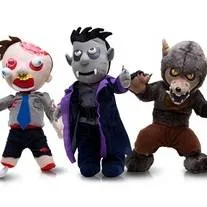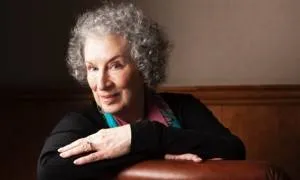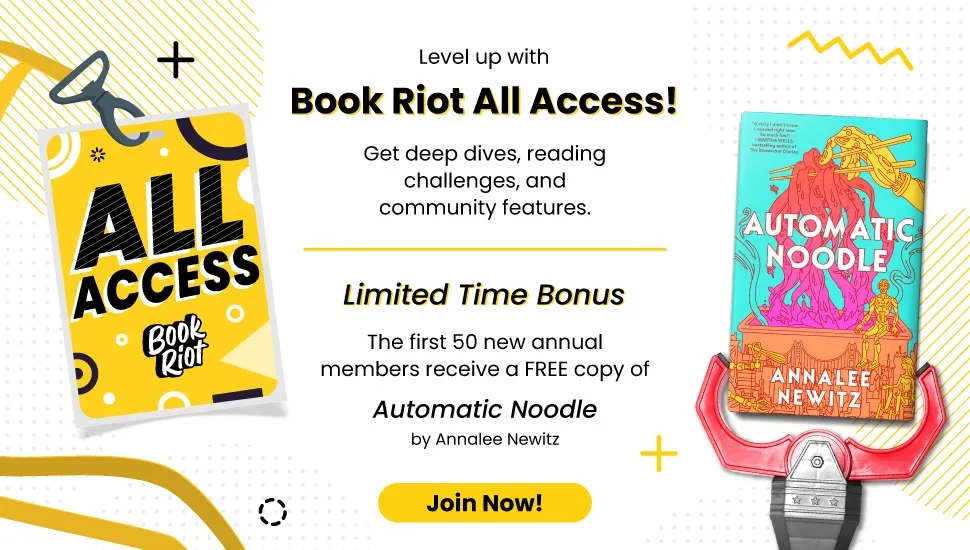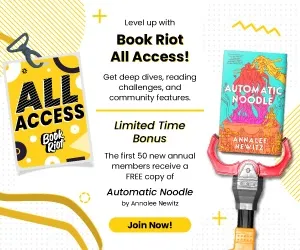
What Carries the Darkness? – Margaret Atwood on Monsters and TWILIGHT
This post is part of our Margaret Atwood Riot Reading Day, a celebration of one of our favorite authors on the occasion of the publication of her new novel, MaddAddam. Check out the full line-up here.
 Have we confused what monsters are for? Like most questions that cross Margaret Atwood’s lips, this one urgently pries open a part of your brain that normally remains unfingered. Because according to her, how we treat the bogeyman can mean everything.
Atwood tossed this hand grenade of a question at an event at the recent Edinburgh International Book Festival. She curated a strand of the programme, which featured her shooting the breeze with Neil Gaiman, discussing weirdness with Ian Rankin, and reflecting upon possibly her finest achievement, The Blind Assassin.
But it was in a session with the opaque title of Writing Under The Influence that she finally got round to talking about zombies. And who wouldn’t want to hear Atwood riff on the undead?
Joining her to gnaw on ghouls were Mary Reilly author Valerie Martin, who grew up reading Edgar Allan Poe in a “strange spooky house in Missouri,” and Naomi Alderman, the British author of The Liars’ Gospel and creator of the Zombies, Run! app, which coincidentally features the vocal talents of Atwood.
“What are monsters metaphors for?” she asked. Childhood fears, innocence, ways of confronting the unpalatable things our conscious thoughts normally censure, are all offered up before Atwood shares her tuppence worth.
“We are seeing a twist on monsters,” she said. “Vampires used to be evil and smelly. Now there is the subgenre of a paranormal romance. It is now desirable to be a vampire. Or a werewolf. People have changed the rules without asking. Instead of being destroyed by sunlight, vampires now sparkle. In Twilight they form cosy domestic units.”
Forget the devil, it’s monsters that literature has all the sympathy for now. “Even zombies are seen as romantic. Look at Warm Bodies. He cleans up wonderfully. But why are we now making friends with monsters?”
The panel do flag up that this is not completely new. Grendel, the beastie from the Old English epic Beowulf, is sympathetic. As is Frankenstein’s monster.
Atwood offers up one answer. “Why do kids love dinosaurs?” she asks as way of a set up. “They can be your friend. You have a large entity on your side.” As a kid, during life’s most vulnerable stage, it means a T-Rex is the best possible comfort blanket. No doubt for many a teenage girl, the idea of Edward Cullen is more than comforting.
But she is not happy to leave monsters and their meaning there. Again she returns to Twlight and the “cosy domestic units” and sunlight-proof skin of the Cullens. By making cuddly what was once evil, “is this a confusion of moral values?”
Please note, this is not delivered as a rant, rather with curious, restless fascination. She continues: “Have we split the monster? Now there are good and bad monsters. Just as in Twilight there are good and bad vampires.”
Which leads her to her ultimate question: If vampires and werewolves, the former forces of darkness, are now our friends, “what carries the darkness that monsters used to carry?”
Alderman provides the most satisfying answer. “It is now the company that created the monster or that profit driven character,” she says. “You couldn’t write a story about a corporation becoming your friend. The darkness is back where it belongs – in human beings.”
But what do you think? Has literature defanged our monsters or do the classical beasts still have the capacity to scare us? What books and stories still carry a measure of darkness? Does ‘splitting the monster’ merely acknowledge that there is good and bad in us all, not just our nightmarish figures?
Have we confused what monsters are for? Like most questions that cross Margaret Atwood’s lips, this one urgently pries open a part of your brain that normally remains unfingered. Because according to her, how we treat the bogeyman can mean everything.
Atwood tossed this hand grenade of a question at an event at the recent Edinburgh International Book Festival. She curated a strand of the programme, which featured her shooting the breeze with Neil Gaiman, discussing weirdness with Ian Rankin, and reflecting upon possibly her finest achievement, The Blind Assassin.
But it was in a session with the opaque title of Writing Under The Influence that she finally got round to talking about zombies. And who wouldn’t want to hear Atwood riff on the undead?
Joining her to gnaw on ghouls were Mary Reilly author Valerie Martin, who grew up reading Edgar Allan Poe in a “strange spooky house in Missouri,” and Naomi Alderman, the British author of The Liars’ Gospel and creator of the Zombies, Run! app, which coincidentally features the vocal talents of Atwood.
“What are monsters metaphors for?” she asked. Childhood fears, innocence, ways of confronting the unpalatable things our conscious thoughts normally censure, are all offered up before Atwood shares her tuppence worth.
“We are seeing a twist on monsters,” she said. “Vampires used to be evil and smelly. Now there is the subgenre of a paranormal romance. It is now desirable to be a vampire. Or a werewolf. People have changed the rules without asking. Instead of being destroyed by sunlight, vampires now sparkle. In Twilight they form cosy domestic units.”
Forget the devil, it’s monsters that literature has all the sympathy for now. “Even zombies are seen as romantic. Look at Warm Bodies. He cleans up wonderfully. But why are we now making friends with monsters?”
The panel do flag up that this is not completely new. Grendel, the beastie from the Old English epic Beowulf, is sympathetic. As is Frankenstein’s monster.
Atwood offers up one answer. “Why do kids love dinosaurs?” she asks as way of a set up. “They can be your friend. You have a large entity on your side.” As a kid, during life’s most vulnerable stage, it means a T-Rex is the best possible comfort blanket. No doubt for many a teenage girl, the idea of Edward Cullen is more than comforting.
But she is not happy to leave monsters and their meaning there. Again she returns to Twlight and the “cosy domestic units” and sunlight-proof skin of the Cullens. By making cuddly what was once evil, “is this a confusion of moral values?”
Please note, this is not delivered as a rant, rather with curious, restless fascination. She continues: “Have we split the monster? Now there are good and bad monsters. Just as in Twilight there are good and bad vampires.”
Which leads her to her ultimate question: If vampires and werewolves, the former forces of darkness, are now our friends, “what carries the darkness that monsters used to carry?”
Alderman provides the most satisfying answer. “It is now the company that created the monster or that profit driven character,” she says. “You couldn’t write a story about a corporation becoming your friend. The darkness is back where it belongs – in human beings.”
But what do you think? Has literature defanged our monsters or do the classical beasts still have the capacity to scare us? What books and stories still carry a measure of darkness? Does ‘splitting the monster’ merely acknowledge that there is good and bad in us all, not just our nightmarish figures?
 Have we confused what monsters are for? Like most questions that cross Margaret Atwood’s lips, this one urgently pries open a part of your brain that normally remains unfingered. Because according to her, how we treat the bogeyman can mean everything.
Atwood tossed this hand grenade of a question at an event at the recent Edinburgh International Book Festival. She curated a strand of the programme, which featured her shooting the breeze with Neil Gaiman, discussing weirdness with Ian Rankin, and reflecting upon possibly her finest achievement, The Blind Assassin.
But it was in a session with the opaque title of Writing Under The Influence that she finally got round to talking about zombies. And who wouldn’t want to hear Atwood riff on the undead?
Joining her to gnaw on ghouls were Mary Reilly author Valerie Martin, who grew up reading Edgar Allan Poe in a “strange spooky house in Missouri,” and Naomi Alderman, the British author of The Liars’ Gospel and creator of the Zombies, Run! app, which coincidentally features the vocal talents of Atwood.
“What are monsters metaphors for?” she asked. Childhood fears, innocence, ways of confronting the unpalatable things our conscious thoughts normally censure, are all offered up before Atwood shares her tuppence worth.
“We are seeing a twist on monsters,” she said. “Vampires used to be evil and smelly. Now there is the subgenre of a paranormal romance. It is now desirable to be a vampire. Or a werewolf. People have changed the rules without asking. Instead of being destroyed by sunlight, vampires now sparkle. In Twilight they form cosy domestic units.”
Forget the devil, it’s monsters that literature has all the sympathy for now. “Even zombies are seen as romantic. Look at Warm Bodies. He cleans up wonderfully. But why are we now making friends with monsters?”
The panel do flag up that this is not completely new. Grendel, the beastie from the Old English epic Beowulf, is sympathetic. As is Frankenstein’s monster.
Atwood offers up one answer. “Why do kids love dinosaurs?” she asks as way of a set up. “They can be your friend. You have a large entity on your side.” As a kid, during life’s most vulnerable stage, it means a T-Rex is the best possible comfort blanket. No doubt for many a teenage girl, the idea of Edward Cullen is more than comforting.
But she is not happy to leave monsters and their meaning there. Again she returns to Twlight and the “cosy domestic units” and sunlight-proof skin of the Cullens. By making cuddly what was once evil, “is this a confusion of moral values?”
Please note, this is not delivered as a rant, rather with curious, restless fascination. She continues: “Have we split the monster? Now there are good and bad monsters. Just as in Twilight there are good and bad vampires.”
Which leads her to her ultimate question: If vampires and werewolves, the former forces of darkness, are now our friends, “what carries the darkness that monsters used to carry?”
Alderman provides the most satisfying answer. “It is now the company that created the monster or that profit driven character,” she says. “You couldn’t write a story about a corporation becoming your friend. The darkness is back where it belongs – in human beings.”
But what do you think? Has literature defanged our monsters or do the classical beasts still have the capacity to scare us? What books and stories still carry a measure of darkness? Does ‘splitting the monster’ merely acknowledge that there is good and bad in us all, not just our nightmarish figures?
Have we confused what monsters are for? Like most questions that cross Margaret Atwood’s lips, this one urgently pries open a part of your brain that normally remains unfingered. Because according to her, how we treat the bogeyman can mean everything.
Atwood tossed this hand grenade of a question at an event at the recent Edinburgh International Book Festival. She curated a strand of the programme, which featured her shooting the breeze with Neil Gaiman, discussing weirdness with Ian Rankin, and reflecting upon possibly her finest achievement, The Blind Assassin.
But it was in a session with the opaque title of Writing Under The Influence that she finally got round to talking about zombies. And who wouldn’t want to hear Atwood riff on the undead?
Joining her to gnaw on ghouls were Mary Reilly author Valerie Martin, who grew up reading Edgar Allan Poe in a “strange spooky house in Missouri,” and Naomi Alderman, the British author of The Liars’ Gospel and creator of the Zombies, Run! app, which coincidentally features the vocal talents of Atwood.
“What are monsters metaphors for?” she asked. Childhood fears, innocence, ways of confronting the unpalatable things our conscious thoughts normally censure, are all offered up before Atwood shares her tuppence worth.
“We are seeing a twist on monsters,” she said. “Vampires used to be evil and smelly. Now there is the subgenre of a paranormal romance. It is now desirable to be a vampire. Or a werewolf. People have changed the rules without asking. Instead of being destroyed by sunlight, vampires now sparkle. In Twilight they form cosy domestic units.”
Forget the devil, it’s monsters that literature has all the sympathy for now. “Even zombies are seen as romantic. Look at Warm Bodies. He cleans up wonderfully. But why are we now making friends with monsters?”
The panel do flag up that this is not completely new. Grendel, the beastie from the Old English epic Beowulf, is sympathetic. As is Frankenstein’s monster.
Atwood offers up one answer. “Why do kids love dinosaurs?” she asks as way of a set up. “They can be your friend. You have a large entity on your side.” As a kid, during life’s most vulnerable stage, it means a T-Rex is the best possible comfort blanket. No doubt for many a teenage girl, the idea of Edward Cullen is more than comforting.
But she is not happy to leave monsters and their meaning there. Again she returns to Twlight and the “cosy domestic units” and sunlight-proof skin of the Cullens. By making cuddly what was once evil, “is this a confusion of moral values?”
Please note, this is not delivered as a rant, rather with curious, restless fascination. She continues: “Have we split the monster? Now there are good and bad monsters. Just as in Twilight there are good and bad vampires.”
Which leads her to her ultimate question: If vampires and werewolves, the former forces of darkness, are now our friends, “what carries the darkness that monsters used to carry?”
Alderman provides the most satisfying answer. “It is now the company that created the monster or that profit driven character,” she says. “You couldn’t write a story about a corporation becoming your friend. The darkness is back where it belongs – in human beings.”
But what do you think? Has literature defanged our monsters or do the classical beasts still have the capacity to scare us? What books and stories still carry a measure of darkness? Does ‘splitting the monster’ merely acknowledge that there is good and bad in us all, not just our nightmarish figures?











